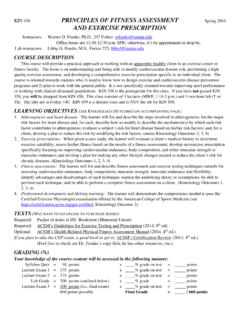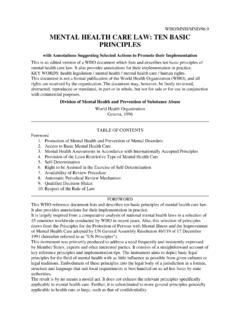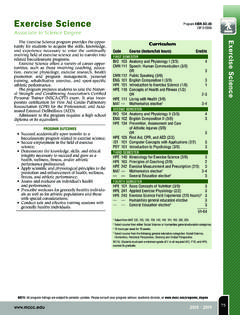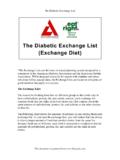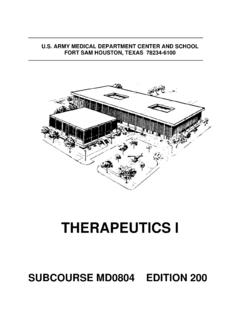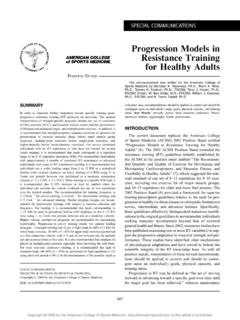Transcription of Guidelines for dispensing of medicines - WHO
1 Guidelines for dispensing of medicines6585 08/10 Guidelines for dispensing of medicinesContentsIntroduction 1 Who needs to use these Guidelines ? 1 Summary of Guidelines 1 Guidelines 11 dispensing precaution safety of prescriptions 12 dispensing multiple repeat prescriptions at one time 13 Facsimile and scanned prescriptions 24 Internet, mail-order dispensing and other indirect supply of medicines 25 Extemporaneous dispensing (compounding) 26 Incident records 27 Labelling of dispensed medicines 28 Counselling patients about prescribed medicines 39 Privacy and confidentiality 410 dispensing errors and near misses 411 Pharmacists workloads 512 Dispensary assistants/dispensary technicians and hospital pharmacy technicians 513 Return of unwanted medicines 6 Attachment 1 Extract of relevant provisions from the Health Practitioner Regulation National Law Act 2009 7p.
2 1 Guidelines for dispensing of medicinesIntroduction These Guidelines have been developed by the Pharmacy Board of Australia (the Board) under section 39 of the National The guideline provides guidance to those registered in the profession in relation to a matter of professional practice, not set down in the legislation or a registration standard, which can be used in proceedings under the National Law as evidence of what constitutes professional conduct or practice for the health profession. The relevant sections of the National Law are needs to use these Guidelines ?These Guidelines are developed to provide guidance to registered pharmacists or those seeking to become registered pharmacists. They apply to all pharmacists registered in the following categories: general provisional limitedThese Guidelines do not apply to students; however, students should become familiar with these Guidelines prior to undertaking supervised practice addition to complying with these Guidelines , pharmacists are encouraged to maintain an awareness of the standards published by the profession, and relevant to their area of practice and category of registration.
3 In considering notifications (complaints) against pharmacists, the Board will have regard to relevant professional practice and quality-assurance standards, depending on the nature of the matter under consideration. Standards should be accessed on the websites of the professional bodies: Pharmaceutical Society of Australia (PSA) The Society of Hospital Pharmacists of Australia (The SHPA) The Pharmacy Guild of Australia (The PGA)Note: As part of the agreement by the Council of Australian Governments to provide for the National Law, ownership of pharmacies, regulation of premises, inspections and related matters do not form part of the National Law, and each jurisdiction will have separate legislation and Guidelines for these must comply with all legislation relevant to the practice of pharmacy in the jurisdiction where the dispensing of guidelinesThis set of Guidelines centre on safe dispensing and labelling of medicines , and on providing a good pharmaceutical service.
4 They also address the training and roles of dispensary dispensing precaution safety of prescriptionsA pharmacist must take reasonable steps to ensure that the dispensing of a medicine in accordance with a prescription or order is consistent with the safety of the person named in that prescription or dispensing a prescription, a pharmacist has to exercise an independent judgment to ensure the medicine is safe and appropriate for the patient, as well as that it conforms to the prescriber s requirements. If there is any doubt, the prescriber is to be conforming to the above principle, dose, frequency and route of administration, duration of treatment, the presence or absence of other medicines , the patient s illness, medication history, and other relevant circumstances need to be taken into dispensing multiple repeat prescriptions at one timeThe simultaneous supply of multiple quantities of a particular medicine ( the supply of multiple repeats at once) may not be in accordance with the prescriber s intention and is contrary to good pharmaceutical practice of supplying multiple quantities of a particular medicine at a single dispensing , or of supplying multiple quantities to a patient even though a prescriber may have provided a blanket request/approval to a pharmacist to do so, is contrary to the National medicines Policy and Quality Use of medicines principles.
5 It does not promote best pharmacy practice in relation to regular review of therapy and effective provision of medicine information, which assists in minimising medication misadventure. The supply of multiple repeats at the one time is permitted under Regulation 24 of the National Health (Pharmaceutical Benefits) Regulations 1960, and each prescription for multiple supplies should be so endorsed. dispensing of multiple quantities of any prescriptions should only occur at the specific direction of the prescriber on each occasion, 1 The National Law is contained in the schedule to the Health Practitioner Regulation National Law Act 2009 (Qld).p. 2 Guidelines for dispensing of medicinesunless exceptional circumstances exist to the satisfaction of the pharmacist, and an appropriate notation is made to that effect on the prescription and in the dispensing Facsimile and scanned prescriptionsA pharmacist may dispense a prescription transmitted by facsimile or scanned copy in accordance with the pharmacist, who has taken reasonable steps to satisfy themselves that the prescription is bona fide and in accordance with relevant State or Territory legislation, may dispense a prescription transmitted by facsimile or scanned copy in advance of receiving the original prescription.
6 An original prescription must still be obtained and retained in accordance with poisons legislation. 4 Internet, mail-order dispensing and other indirect supply of medicinesThe Board views the indirect supply of medicines , such as internet and mail-order dispensing , as less than the optimal way of delivering a pharmacy service because communication may be compromised. The Board recognises, however, that there are circumstances where these forms of communication are necessary in, or appropriate to, the patient s circumstances ( in remote areas).GuidelinesA pharmacist supplying medicines indirectly to a patient must comply with all relevant State or Territory, and Commonwealth legislation, the Pharmacy Board of Australia s Guidelines for dispensing of medicines , and established practice and quality assurance Extemporaneous dispensing (compounding) The Board recognises that pharmacists are required to compound and dispense medicines extemporaneously.
7 An extemporaneous preparation should be used only in circumstances where a commercial product is unavailable or must ensure that, in the absence of any formulation published in a standard reference, there is good clinical and pharmaceutical evidence to support the quality, safety, efficacy and rationality of any extemporaneous formulation. Evidence is best obtained from peer-reviewed journals, rather than being solely based on testimonials and care should be exercised in the case of medicines for which there are no precedents in standard references. Examples are oral and topical hormone preparations, those containing substances whose use has not been approved in Australia for therapeutic use, and preparations that contain well-established drugs for oral use, but for which there are inadequate safety and efficacy data when the same drug is used formulations should only be made up if there is credible in vivo and in vitro data that support the quality, safety, efficacy, rationality and relevance of the precise substances to commercially manufactured medicines is discouraged because the full formulation details of the latter are not generally Board has regard to the Australian Pharmaceutical Formulary and Handbook s statement on extemporaneous dispensing , to established practice and quality standards, and to current State or Territory, and Commonwealth.
8 The Board is aware that there is a review of current compounding practices in pharmacy being undertaken by the Therapeutic Goods Administration and this guideline will be further considered when the results of that review are known. 6 Incident recordsDispensing errors, significant other errors, omissions, incidents, or other noncompliances, including complaints of a noncommercial nature arising both within and external to the pharmacy, may be the subject of investigation. Pharmacists should therefore follow a risk management procedure, including appropriate record keeping. GuidelinesThe record is to show when the incident was recorded, when it occurred, who was involved (both actual and alleged), the nature of the incident or complaint, what actions were taken and any conclusions. If contact was made with third parties, such as government departments, prescribers, lawyers or professional indemnity insurance companies, details of the conversation should be of how serious the incident may appear, comprehensive detailed records need to be kept.
9 The record should be kept for three years because of the delayed nature of some forms of Labelling of dispensed medicinesPharmacists are to label dispensed medicines in accordance with any statutory provisions and these Guidelines with a view to: p. 3 Guidelines for dispensing of medicines maximising the benefits of the therapy improving the patient s understanding of the treatment enhancing compliance minimising adverse effects. Relevant legislation in force in the jurisdiction in which the pharmacist is practising should be LabelsThe placement of the dispensing label on the product is largely determined by the design of the medicine package and the manufacturer s label. The dispensing label is to be firmly attached to the immediate container (including each component of multiple-therapy packs) unless the immediate container is so small or is so constructed that the label would compromise the patient s ability to use the medicine ( metered aerosols and some eye drops).
10 In such instances, the label should be attached to the primary pack or alternatively, purpose-designed labelling tags or winged labels may be label should be clearly and legibly printed in unambiguous and understandable English; other languages that are accurate translations of the English may be used in addition to special needs of patients with disabilities, such those with poor eyesight, should be accommodated and the patient adequately label should be placed to leave visible any of the manufacturer s statements that may be important to the patient, including the expiry date, storage conditions and where possible, the name and strength of the Label contentThe label is to include the following: the brand and generic names of the medicine , the strength, the dose form and the quantity supplied; for extemporaneously prepared medicines and medicines not dispensed by count, the name and strength of each active ingredient, and the name and strength of any added preservatives or the name of the formula as described in a standard reference book specific directions for use, including frequency and dose the patient s name or, in the case of an animal, the owner s name and the kind of animal the date of dispensing or supply the dispenser s (and if different, the checking pharmacist s) initials a unique identifying code the name, address and telephone number of the pharmacy or pharmacy department at which the prescription was dispensed storage directions (where important) and expiry date (where applicable) the words Keep out of reach of children.










